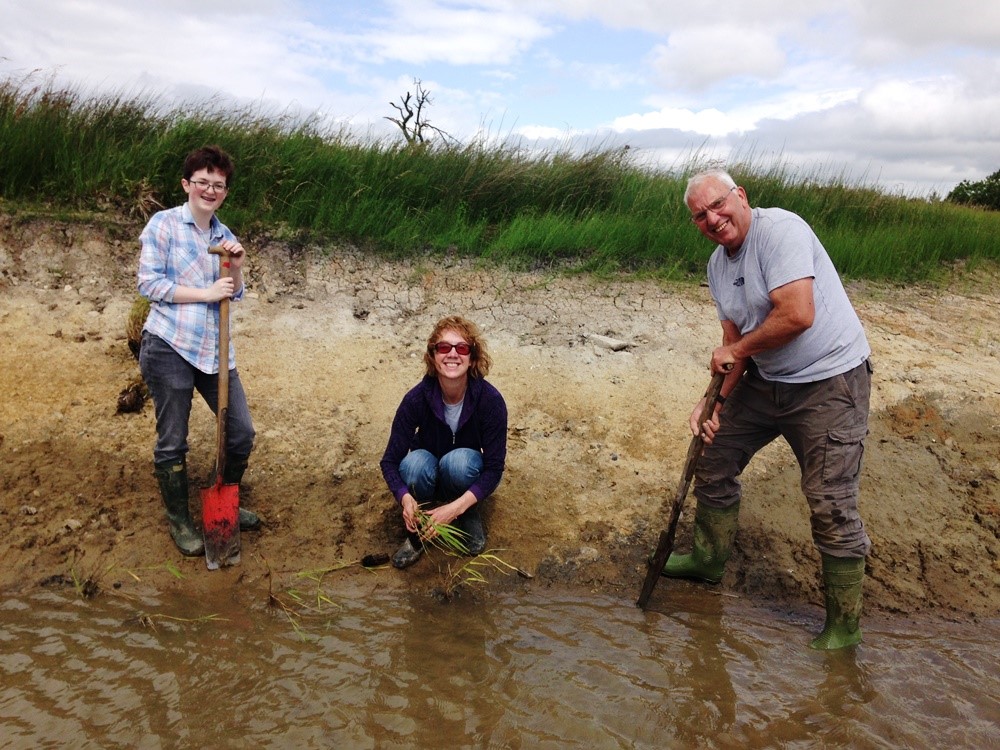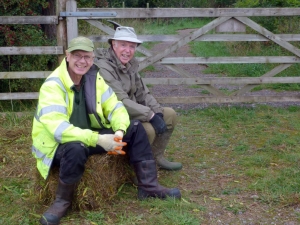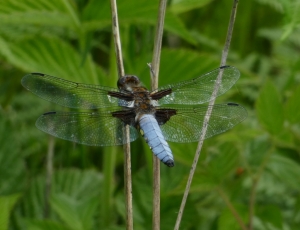Blog Archive (24) Posts Made in November 2014
Sun!
Sunday, November 30th 2014
The weather has been damp, dark, wet, misty and foggy for several days. Today the sun was rising as the bird ringers arrived! For the first time in many years there was a view through the willow carr to the conifer trees near the moor, this a direct result of the oustanding achievements of our willow coppicing volunteers. The sun could be seen catching the tops of these trees as the nets were opened.
Approaching the lake the glowing yellow orange of the larch trees stood out.
There were many birds retrapped today, as is usual at this time of year. The birds that flock to Foxglove during late autumn and winter to feed have not yet arrived, and numbers of winter thrushes have been well down on previous years with natural food presumably still plentiful in their summer haunts. However there was a surprise when two juveniles and an adult Redwing were brought to the ringing room. These birds are winter migrants from Scandinavia.
Earlier in the week Tree Sparrows were recorded at the lake feeders. Today one was ringed! (Dreaming - next breeding season Tree Sparrows in our nest boxes ...........??). Although not really scarce in North Yorkshire they are very handsome birds and very nice to see on the reserve. This was only the second ringed on the reserve in 22 years!
Over a hundred birds were caught today in just a morning session. Thank you to everyone who helped and congratulations to the new recruits who did exceptionally well!
More Fungi!
Saturday, November 29th 2014
Brian and Christine went exploring and found yet more fungi. This is Russula torulosa , a dark red fungus which was found in our conifer woodland.

This Leaf Parachute fungus, lives up to its name and grows on dead leaves. It is a very small fungus and is easily missed.

Thank you to Brian and Christine for their investigative work, needed to identify the fungi.
Kittiwake Research at Cape Wrath
Friday, November 28th 2014
While the ringing team were at Cape Wrath at the beginning of July they were joined by two members of staff from the RSPB, Stacey and Emily, who were using GPS data loggers to monitor the feeding behaviours of Kittiwakes along the coast of Scotland. This work was done as part of the RSPB’s Sea Bird Tracking and Research project.
Kittiwakes build their nests in colonies on cliff faces. Each year several are ringed - but catching them is no easy feat! Adults have to be carefully hooked and lifted off the nests making sure eggs and chicks are not disturbed. They quickly become wary of the catching methods and fly off if approached at anything other than a very sedentary pace.
Once the adults have been ringed a ladder is used to gain access to the nests to ring the chicks that have hatched. This is done as quickly as possible in order to minimise the time that adults are away from the nests.
This year as well as being ringed 8 birds had a small, lightweight GPS tracker attached to the feathers on their backs. These birds then had to be caught again some days later to remove the tags and download the data. Although the data produced is accurate and almost instant it is quite a difficult business having to catch the birds for a second time. Each bird was colour marked to aid recapture. The coloured marks wear off after only a few days and cause no harm to the bird. The tags were attached to the feathers by tape and if not removed, these will naturally fall off after only a few days. You can see one of the black trackers in the photograph below.

Access to the Kittiwake colonies can often be tide dependant so there were only a few opportunities to return to try and recover the GPS data loggers. Despite all of the factors against us, five of the eight birds were recaptured and the trackers recovered which was quite an achievement.
The tracks below show the journeys made by three of these birds from the colony on the east side of Faraid Head when foraging at sea for food; each colour represents a different day. The birds had their own distinctive foraging habits with some travelling up to 210 miles in one foray to obtain sufficient food to sustain their young. Others foraged much closer to the colony.
This bird travelled the smallest distance from the cliff, on the second day (pink) travelling only a few miles.

This bird made the longest foray (blue) with three journeys in one day totalling over 200 miles on each journey.

We found that the birds often followed a similar foraging pattern although visiting slightly different locations. The bird below conducted a late evening fishing trip then turned round at midnight and headed back to its nest in the dark!

It was very interesting and rewarding for the ringers to be part of the team helping to collect data for this important project. Stacey has since been in contact updating us on her travels; currently she is on Signy Island in the South Orkney Islands of Antarctica working on conservation projects with the British Antarctic Survey. She sent us this photograph earlier today of penguins in Signy Bay down below the Falkland Islands. The maps were kindly produced for us by the RSPB.

Feathers, Flowers and Fungi
Wednesday, November 26th 2014
Our ‘Meet the Birds’ guided walk set off from the Field Centre as the rain began to fall this morning; not ideal conditions for seeing the birds living at Foxglove! Despite the weather the walk was enjoyed and took in several of the different habitats found on the reserve. We started near the conifer block listening for Goldcrest and were lucky enough to see them flitting between the tree tops.
We then headed along the red route to the moorland where after seeing a Kestrel we were distracted by a sighting of Hairy Earthtongue, a new species of fungus found on the reserve for the first time last week.
While in the hide we were treated to good views of Little Grebe and a Kingfisher sitting and fishing between two patches of reed. In total, 19 different species of bird were seen.
Volunteers were out in force again today, spending their time surveying fungi and flowers. Several new species of fungi have been found – we will update you once identifications have been confirmed. The ladies on the flower walk had a surprise finding Primrose in bloom along Risedale beck, not normally seen until the weather warms at the end of winter!
Volunteers Step Up
Tuesday, November 25th 2014
Today we split into two groups to complete different tasks around the reserve. Adam took a willing team down to the lake hide to tackle the problem of the very slippery steps that lead to the top hide. They worked diligently all morning and part of the afternoon attaching a wire covering to create a non-slip surface.

The other team of volunteers and Matt continued the coppicing effort. This morning we concentrated on a section across the other side of the net ride from the main block. We had envisaged that this would take us most of the day however the volunteers cracked on and got it done by lunch time.
It is sometimes difficult for us to assess exactly how much has been done in a day as the block is so large. However this morning gave us a clear indication of how much work the team of volunteers get through and we are very impressed to say the least. So once again thank you for all your hard work!
There’s not mushroom in here!
Monday, November 24th 2014
With the damp conditions, fungi are putting on a particularly good display all around the reserve. Our eagle eyed volunteers have been out in the reserve surveying fungi, and have found five new species this year.
Christine spotted and identified the fungus below, it was found just outside the gate leading onto the moor from the lake, as Hairy Earth Tongue. Earth Tongues are mostly late autumn fungi, usually appearing in October and lasting well into November (unless cut down by frosts) and grow on nutrient poor soils.

Brian spotted the fungus below in the leaf litter of the conifer plantation. After a bit of investigation, aided by Christine it has been identified as Velvet Bolete another new species for the reserve. This soft-fleshed bolete is far from common in Britain and mainly appears under various kinds of pine trees. Like all bolete-like species it has tubes, and pores, instead of gills under its cap.
With over 2440 species already identified on the reserve it amazes us that we continue to discover new species all the time. This in the main is down to the our volunteers so we would like to express our gratitude for their continued hard work and dedication.
Reflections
Sunday, November 23rd 2014
A blog of few words. Over the last two weeks wind speed has been low and the lake and ponds have been like mirrors, allowing beautiful reflections to be seen and photographed.
These are remains of Cotton Grass stems, seen in one of the ponds in the Scrapes.

Where do the stems begin and end?

Trees around the edge of the lake are reflected in the still water.

Fungi Again
Saturday, November 22nd 2014
As Autumn began we were bemoaning that there were very few fungi around the reserve. It was warm but not damp. Now that Autumn is drawing to a close, it is mild and wet. Fungi are flourishing and new species are being recorded.
However there are still some of the old favourites around. On the first of November a round white fungus was observed and after initial excitement we realised that it was a Fly Agaric. Spores are released from the gills.
Some fungi are now 'going over' and certainly do not have the ahh factor. Insects and slugs often feed on the fungi. Discussion took place as to what had done the damage to this one.
Yellow Rattle seeds were scattered across the middle moor. This semi-parasitic plant reduces the growth of grasses and allows flowers to grow. Across the middle moor, bright green, almost circles of grass, are easily noticed. These are places where there are mycelium of fungi, growing in the soil, releasing nutrients for the grass to grow! A watch will be kept to see if any fruiting bodies appear.
Spring and Summer could be interesting to see which flowers grow where!
Looking Forward
Thursday, November 20th 2014
Our 2015 Calendar has now arrived and is on sale for £6.00 in the Field Centre. This year it is looking fantastic with 12 beautiful images of wildlife and views around the reserve, all taken by volunteers and staff.

Just a reminder that our Christmas Party is on the 17th December, starting at 7pm in the Mess at Wathgill. There will be plenty of festive fun with live music, quizzes, a raffle and of course some delicious food. Tickets are only £12, please speak to Adam or Matt to book yours.
Wednesday Volunteers
Wednesday, November 19th 2014
Volunteers have had a busy morning surveying species on the reserve. Firstly the moths, caught overnight in our light trap were identified. Six species were recorded this morning including the December Moth and Mottled Umber. Once this was finished the group split, half looking for fungi and the other half looking for birds.
Several species of fungi were seen including Green Elf Cup, Snapping Bonnet and a new species for the reserve, an Earththongue – the exact species is still to be determined! The birders also came back for lunch with an exciting record – a Tree Sparrow, one of only a handful of sightings of these birds on the reserve.
Ruth and Elizabeth were in again working on the touchscreen project, they were measuring and cutting fabric ready to make a cover for when this is not in use. The grand unveiling is on Saturday 6th December at 10am, if you would like to come along to see this fantastic resource please let us know.
As always thank you all for you work today and for making the reserve such a friendly place to be!
What a Transformation!
Tuesday, November 18th 2014
Nineteen volunteers joined us in the Scrapes today to continue working on the coppice block. We also started work thinning some of the Hawthorn from the cleared area. In no time at all the fire was roaring and the site was a hive of activity. Pupils from the Dales School also helped out during the morning, learning new skills as they worked alongside our volunteers.
These two photos, taken from the same point, highlight the transformation that has taken place alongside the scrapes thanks to an astounding effort from all those involved.
This picture was taken on October 14 as we started work.

This picture was taken today as work continued.
The coppicing has been done to a high standard; very much a reflection of the hard work from our dedicated team of volunteers. While there is still a large area to complete we have now made a fantastic start to our winter work - thank you all for the efforts you have put in today and over the past month.
Hidden Worlds
Sunday, November 16th 2014
Conditions this morning were ideal for bird ringing, no wind, almost blue sky and sun, with just a hint of mist.
A hidden world was revealed. Spiders had been busy overnight. Their webs were strung across plants and between grasses. Often a single strand of silk spread across several feet.
We usually see the webs in the Gorse.
They are rarely seen in Hawthorn.
Some of the webs were coated in dew drops.
What a fascinating night 'a fly on the wall' could have had watching spiders work so hard to produce such works of art.
Another hidden world is that of the birds of Foxglove. A quick movement, a cheep or a call can be recognisable to many bird watchers. Seeing birds in the hand reveals a new world and a totally different view.
A Grey Wagtail, possibly not always the same one, has been seen on the lake recently, particularly near the bridge. This species tends to move to lower ground for the winter, often seen on lowland streams and on farm land, where they feed on insects, so it is a little surprising that they are still at Foxglove. This juvenile was ringed today.
There have not been many birds seen flying and there has been little song heard over the last few days, but the birds are still around! The ringing team were busy today and over 270 birds were processed, many of them new birds caught for the first time.
Eight new Bullfinch were ringed and 12 Lesser Redpoll, as well as Willow Tit, Marsh Tit, and several Goldcrests. Reed Buntings have been scarce during early Autumn but their numbers too are beginning to increase and 8 new birds were ringed. (Listen for them as you walk through the reed bed.)
Many visitors came to the ringing room and were amazed at seeing birds in the hand. Under supervsion they released some birds. something that they will remember for a long time.
Many thanks to the 10 bird ringers and 2 new starters who took part - and to everyone who supported them today.
Late Autumn Colours
Saturday, November 15th 2014
Grey skies do not make the best backgrounds for photography and certainly do not show off the Autumn colours to their best. However even the very dark heavy clouds did not spoil the Autumn colours yesterday morning.
The willow stems were red against the last of the yellow leaves. These young willow stems will be used for the Willow Weaving event. It is as though they have been grown to order, just the right size!!
Through the Scrapes, willow leaves, Silver Birch leaves, the dark branches of leafless trees and bright red Holly berries made an artist's palette.
Reeds make musical sounds as the wind blows through them. It mixes the yellow, green and brown colours together.
Now that it is damp the lichens are standing proud of the branches they grow on. Flash enhances their colours even more.
Autumn is the season when animals hibernate, seeds are dormant, trees lose their leaves and few flowers blossom. Ivy is one that does. Its almost lemon flowers stand out agasint the dark green shiny leaves. Damp, wet and feeling cold, did not deter insects of many sizes covering the flowers of Ivy along Risedale Beck.
This particular flower was host to a ladybird, 7 Spot possibly.
Festive Fun
Friday, November 14th 2014
We are now taking bookings for our Christmas Party. Festivities will be kicking off at 7pm at Wathgill on Wednesday 17th December. As usual there will be some fun quizzes, a delicious three course Christmas Dinner with some live music by local ceilidh band Compass Rose. Tickets for all of this are just £12, and all are welcome to come along and join us for the evening. To book see our events page or let us know next time you are visiting the reserve.

We have just opened the Foxglove Christmas Raffle which will be drawn at the Christmas Party. If you have any items to donate for prizes please leave them on the raffle table in the Field Centre or give them to a member of staff or volunteer. First prize will be a fantastic hamper, filled to the brim with delicious treats for the holidays. There will also be a good range of other prizes to be won. Tickets are now on sale in the Field Centre priced at £1 per strip.
Team Cappuccino Strikes Again!
Thursday, November 13th 2014
Seventeen volunteers (collectively known as Team Cappuccino) arrived bright and early at Richmond Town Hall to set up for our fundraising Coffee Morning.
There are so many people to thank, from those that donated prizes for the raffle and tombola as well as items for the bric-a-brac stall, the bakers who made such delicious cakes, those who ran the stalls, made the coffee, washed up and those who organised the event. The whole morning was such a success and our volunteers created such a lovely and welcoming atmosphere for all those who dropped in for their coffee.
The totals were once again record breaking(!) with £183.50 taken on the Door and Raffle. Cake sales raised us £89.60 and Bric-a-brac made us £35.25. The Tombola was as popular as every bringing in £45.00 and finally sales of items from the Foxglove Shop made £75.80. The grand total, minus expenses, came to £401.60, this is over £50 more than at the last coffee morning in June!
Well done everyone, and thank you all again!
An Interesting Find
Tuesday, November 11th 2014
Volunteers once again found themselves working in our coppice block today. We continued cutting back willow and Silver Birch as well as starting to thin some Hawthorn trees. Walking from the Field Centre down towards the lake you will see that real progress has been made clearing this area over the past few weeks.
This Gorse Shield Bug was spotted by Brian and John during the afternoon. This large shield bug is most commonly associated with Gorse, though is frequently found on other plants in habitats where Gorse is present. Early in the summer freshly emerged adults will be bright green, though as in many other shield bugs, this species frequently becomes darker prior to hibernation.
Thank you again everyone for your help.
Pollarding
Monday, November 10th 2014
Following our busy winter worky day last Saturday the Reserve Managers continued in the coppice block. Work concentrated on thinning Hawthorn and pollarding willow.
Pollarding involves removal of the upper branches of a tree, promoting a dense head of branches. Pollards once were used to demarcate boundaries where hedges were not suitable. At Foxglove we pollard willow and some other trees along net rides to ensure that vegetation is kept at the right height for bird ringing. Birds tend to travel between the tops of trees so if vegetation is too high around mist nets, they simply fly over the top of them.
Far and Near
Sunday, November 9th 2014
Those older people who read the blog will remember the frustration of taking photographs, finishing the role of film, taking it to a shop and then waiting for a week or so for the photographs to be returned. Then the disappointment of a blurred image. A photograph that could not be taken again.
Today we have digital photography. Amazing, click, look, take another if it is not just what you wanted. Technology and the lens, now mean close ups and zoom shots are the norm.
Having said that this photograph of the Kingfisher in the Ash tree above the lake, really was pushing the camera to its limits! But you can see the colours, just.

There may be a slight hint of competiton for Kingfisher photographs! John took one earllier in the week. Today it was Glennis's turn. This is titled 'Got one!!'
Nature is amazing and you never know what you are going to see when you head out for a stroll around Foxglove. Take your camera and keep clicking away!
Winter Worky Day Part One
Saturday, November 8th 2014
Today we had the first of our winter worky days for the season. Despite the less than favourable weather forecast we still had an amazing turn out of volunteers. There were lots of regular faces and we were really happy to welcome some new ones as well.
The Task for the day was to continue the work we have been doing in this year’s coppice block. After a quick briefing it was off to work taking out Silver Birch, Gorse and coppicing the willow.
After a little bit of persuasion we got two fire sites going today meaning that the brash didn’t have to be dragged right across the site and that the fires were kept manageable and under easy control all day.
We stopped at lunch time for a well-deserved curry feast and a variety of delicious cake like treats and the obligatory group photo. After lunch the hard work continued and everyone was in high spirits having fun despite the rain putting a slight dampener on things.
We would like to thank everyone who came and contributed today we really appreciate you all coming on your weekends and giving your time to help make Foxglove the place it is we couldn't do it without you. We hope you all had a good day and that we will see you all again on the 6th of December for the next instalment of our winter worky days.
Kingfisher
Thursday, November 6th 2014
On Tuesday, John took this fantastic photograph of a Kingfisher from the hides at the lake, the colours are fantastic and the black lower mandible shows it to be a male. Sightings of the Kingfisher, along with Grey Wagtails and Little Grebe are still being reported on a daily basis so come for a visit over the weekend and you might be lucky enough to catch a glimpse of one!

Preparations
Thursday, November 6th 2014
Four volunteers arrived bright and early to help us continue with work in our coppice block. We set about clearing an area for a new fire site, ready for the Winter Worky Day this weekend.
We soon had a roaring fire going and made good progress clearing out Silver Birch and coppicing the willow stools. Thank you again everyone for your hard work here.
What a busy day
Wednesday, November 5th 2014
Yesterday was a very busy day at Foxglove. We had a fantastic turn out with twenty-four volunteers here in a number of capacities. The main job for the day was the removal of Gorse and Silver Birch from an area along the access track.
With such a large number of hard working volunteers we were able to get a fantastic amount removed and transported to the fire site on the car park. The Dales School also pitched in and did a great job dragging brash for us.
As a little reward for all the volunteers hard work we had a lunch cooked on the fire. Felicity, Gordon and Anne created some lovely treats and we all got tucked into jacket potatoes, stuffed and garlic mushrooms, twister dough, parkin, toasted tea cakes, stuffed apples and a few toasted marshmallows.
At the end of the day just as the light started to fade we had the guys from Big Sheep Little Cow come collect the Dexters from the Wetland. Much to our surprise (they are obviously professional cow herders unlike us) they managed to round them up and transport them away for another year.
There was real buzz around the reserve all day with lots of jokes, smiles and hard work and we would like to thank everybody who contributed to such a fantastic day.
Finally we would like to thank Garth (who has at last managed to move house) for all his hard work over the years. Your smiling face and dedication to Foxglove will definitely be missed and we will be happy to welcome you back anytime you can make it!
Preparing for Next Year
Sunday, November 2nd 2014
Although colder than last week, it is not the weather we expect for this time of year. Bird ringing this morning reflected the weather conditions. The summer migrants have left for even warmer countries but the winter migrants have not yet arrived on the reserve in any number and were absent from the nets. Some winter thrushes have been seen and a few Redwing, Fieldfare and Blackbirds were feasting on our good crop of Hawthorn berries.
Around Christmas time we begin to see the leaves of Honeysuckle breaking their buds. Today some fresh green leaves were spotted. If you look closely you can see that the leaves have tiny hairs on them, which presumably will help to protect them when the weather does turn colder and there are frosts around.
Silver Birch is full of seeds, which will really please our reserve managers and volunteers, as each seed is more than likely to grow into a new Silver Birch tree! Many leaves have already fallen, those left are golden yellow. However the tree is already preparing for its next growing season. The male catkins can be seen.
Italian Alder (we have identified these trees correctly!) is also preparing for next year. Female cones, the dark brown ones, have dropped their seeds. Ready for the next growing season are the green female cones.
Male catkins, unlike 'our' Alder are more red.
A check on the outside walls of the Field Centre can often reveal a variety of different invertebrates. Today there were caddis fly but little else. Then this insect was spotted. It had six legs so it was definitely an insect and then the realisation that it was a female moth. It can only have walked there!
Photographed in situ.
After checking the reference book it was found to be a female Mottled Umber moth. Then it was carefully moved to a leaf for another photograph. Some female moths are very small and have no wings. In this case it has minute wings. Having enlarged several photographs no wings could be seen! They do not move far and produce pheromones which attract the male moths. Male moths often have large antenna to enable them to pick up the pheromones.
The male of this species was caught in the moth trap on Wednesday. It was not the most co-operative of moths to photograph. These moths overwinter as an egg on the food plants, which include Hawthorn, Blackthorn, Goat Willow and Hornbeam - all grow on the reserve. Larva appear from early April to late June and the adults fly from October to January.
Each species of plant and animal have their own strategy to survive winter, be it mild or hard.
Plants and Autumn
Saturday, November 1st 2014
Whilst out flower hunting on Wednesday, a stop was made to look at a fungus. It was green, and almost hidden in the grass. On investigation it was found to be Verdigris Agaric (Stropharia aeruginosa) and it was a new species for the reserve. (Thanks Christine for the ID.)

By Friday it had aged and had lost its green colour looking more yellow.

We also got excited over another fungus. But when closely examined we could just see the red showing. It was a very young Fly Agaric.

As this grows so the fruiting body shows red.
Red can also be seen through the vegetation as the Bramble leaves show their autumn colours.
Larch trees are now turning yellow and soon their needles will be covering the paths near the moor and in the woodland.

One of the flowers recorded was Ivy. This is a very important flower at this time of year, for the late flying insects who feed on the nectar and pollen.
And finally nothing to do with plants but a little to do with Autumn. Out watching the lake, looking for the Kingfisher, Grey Wagtail and the Otters, this Roe Deer Doe watched us watching her.





.JPG)





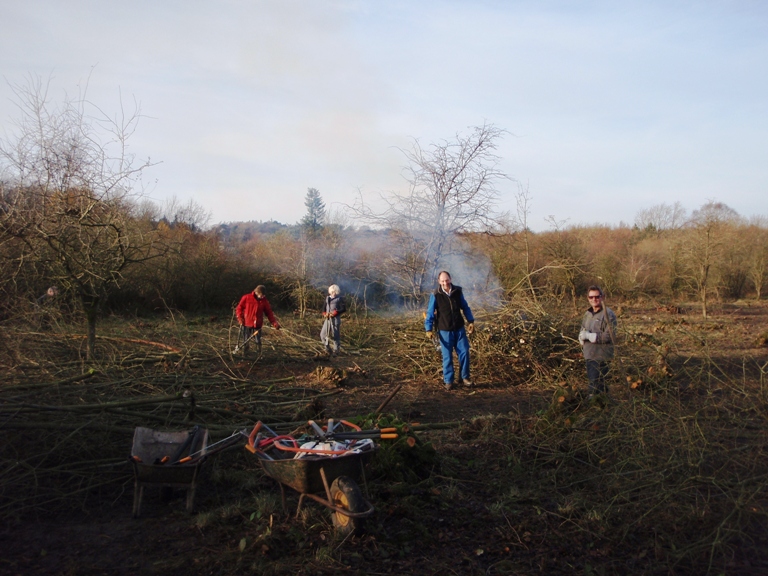
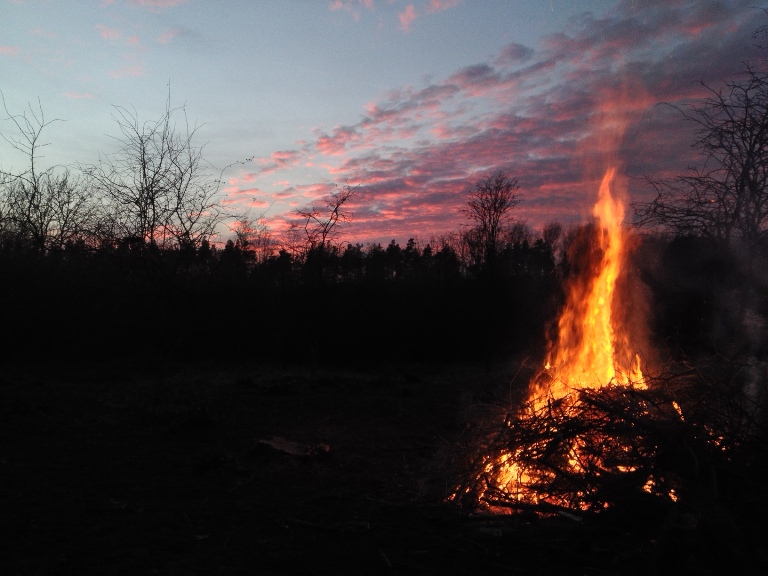













.JPG)











.JPG)
























